Basis of Classification Online Test 7th Science Lesson 11 Questions in English
Basis of Classification Online Test 7th Science Lesson 11 Questions in English
Basis of Classification Online Test 7th Science Lesson 11 Questions in English
Quiz-summary
0 of 47 questions completed
Questions:
- 1
- 2
- 3
- 4
- 5
- 6
- 7
- 8
- 9
- 10
- 11
- 12
- 13
- 14
- 15
- 16
- 17
- 18
- 19
- 20
- 21
- 22
- 23
- 24
- 25
- 26
- 27
- 28
- 29
- 30
- 31
- 32
- 33
- 34
- 35
- 36
- 37
- 38
- 39
- 40
- 41
- 42
- 43
- 44
- 45
- 46
- 47
Information
Basis of Classification Online Test 7th Science Lesson 11 Questions in English
You have already completed the quiz before. Hence you can not start it again.
Quiz is loading...
You must sign in or sign up to start the quiz.
You have to finish following quiz, to start this quiz:
Results
0 of 47 questions answered correctly
Your time:
Time has elapsed
You have reached 0 of 0 points, (0)
| Average score |
|
| Your score |
|
Categories
- Not categorized 0%
| Pos. | Name | Entered on | Points | Result |
|---|---|---|---|---|
| Table is loading | ||||
| No data available | ||||
- 1
- 2
- 3
- 4
- 5
- 6
- 7
- 8
- 9
- 10
- 11
- 12
- 13
- 14
- 15
- 16
- 17
- 18
- 19
- 20
- 21
- 22
- 23
- 24
- 25
- 26
- 27
- 28
- 29
- 30
- 31
- 32
- 33
- 34
- 35
- 36
- 37
- 38
- 39
- 40
- 41
- 42
- 43
- 44
- 45
- 46
- 47
- Answered
- Review
-
Question 1 of 47
1. Question
1. ______ number of species of living organisms have been identified and named till now
Correct
Explanation
We see various plants and animals around us. It is estimated that about 8.7 million species of living organisms have been identified and named till now.Incorrect
Explanation
We see various plants and animals around us. It is estimated that about 8.7 million species of living organisms have been identified and named till now. -
Question 2 of 47
2. Question
2. Which of the following statement is incorrect?
1) In order to know about the behaviour and relationship among organisms, that are known,
biologists have classified them into two broad groups, plants and animals
2) Grouping of living organisms based on their common features is known as biological classificationCorrect
Explanation
Many scientists believe that, only a small portion of the total species existing on earth has been identified. In order to know about the behaviour and relationship among organisms, that are known, biologists have classified them into two broad groups, plants and animals. Grouping of living organisms based on their common features is known as biological classification.
Incorrect
Explanation
Many scientists believe that, only a small portion of the total species existing on earth has been identified. In order to know about the behaviour and relationship among organisms, that are known, biologists have classified them into two broad groups, plants and animals. Grouping of living organisms based on their common features is known as biological classification.
-
Question 3 of 47
3. Question
3. Classification of living organisms is based on_____
1) Characteristics
2) Similarities
3) DifferencesCorrect
Explanation
Living organisms are so large in number that they need to be classified into smaller groups.
Classification of living organisms is made on the basis of their characteristics, similarities and differences.Incorrect
Explanation
Living organisms are so large in number that they need to be classified into smaller groups.
Classification of living organisms is made on the basis of their characteristics, similarities and differences. -
Question 4 of 47
4. Question
4. Match the following:
I. Warm – Blooded 1. Reptiles
II. Cold- Blooded 2. Birds
III. With Jointed Legs 3. Worm
IV. Without Legs 4. With 3 pairs of legCorrect
Explanation
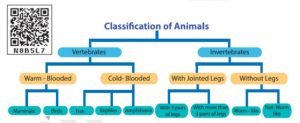 Incorrect
Incorrect
Explanation

-
Question 5 of 47
5. Question
5. Who classified animals into those ‘with blood’ and those ‘without blood’ before 2400 years?
Correct
Explanation
Aristotle was a Greek philosopher and thinker who lived about 2400 years ago.
He classified all organisms into either animals or plants
Then he classified into those ‘with blood’ and those ‘without blood’.
Then the animals are classified into three groups based on their method of movement: walkers, flyers or swimmers.Incorrect
Explanation
Aristotle was a Greek philosopher and thinker who lived about 2400 years ago.
He classified all organisms into either animals or plants
Then he classified into those ‘with blood’ and those ‘without blood’.
Then the animals are classified into three groups based on their method of movement: walkers, flyers or swimmers. -
Question 6 of 47
6. Question
6. Which of the following about necessity of classification is correct?
1) Classifying things makes it easy for us to know their similarities and differences
2) Classification helps us to understand, living and non – living things in better way
3) Things with similar characters are classified into same groupCorrect
Explanation
Why do we classify things?
1. Classifying things makes it easy for us to know their similarities and differences.
2. Things with similar characters are classified into same group. These things are usually similar
in at least one characteristic.
3. Things with different characteristics are classified into different groups. These things are
usually different in at least one characteristic.
4. Classification helps us to understand, living and non – living things in better way. For example, we can classify a newly discovered organism, we would come to know, how it relates with other.Incorrect
Explanation
Why do we classify things?
1. Classifying things makes it easy for us to know their similarities and differences.
2. Things with similar characters are classified into same group. These things are usually similar
in at least one characteristic.
3. Things with different characteristics are classified into different groups. These things are
usually different in at least one characteristic.
4. Classification helps us to understand, living and non – living things in better way. For example, we can classify a newly discovered organism, we would come to know, how it relates with other. -
Question 7 of 47
7. Question
7. Who introduced the hierarchy of categories?
Correct
Explanation
The system of arranging taxonomic categories in a descending order based on their relationships
with other group of organisms is called hierarchy of categories”. This system was introduced by Linnaeus and is called Linnaean hierarchy.Incorrect
Explanation
The system of arranging taxonomic categories in a descending order based on their relationships
with other group of organisms is called hierarchy of categories”. This system was introduced by Linnaeus and is called Linnaean hierarchy. -
Question 8 of 47
8. Question
8. Which of the following is the basic unit of classification
Correct
Explanation
There are seven main categories of hierarchies namely, Kingdom, Phylum, Class, Order, Family, Genus and Species. Species is the basic unit of classification
Incorrect
Explanation
There are seven main categories of hierarchies namely, Kingdom, Phylum, Class, Order, Family, Genus and Species. Species is the basic unit of classification
-
Question 9 of 47
9. Question
9. Which of the following are examples of Protozoa?
Correct
Explanation
 Incorrect
Incorrect
Explanation

-
Question 10 of 47
10. Question
10. Multicellular organisms with holes in the body are called as_____
Correct
Explanation
 Incorrect
Incorrect
Explanation

-
Question 11 of 47
11. Question
11. Which of the following belong to phylum Coelenterata?
Correct
Explanation
 Incorrect
Incorrect
Explanation

-
Question 12 of 47
12. Question
12. Which of the following is/are hermaphrodite?
Correct
Explanation
 Incorrect
Incorrect
Explanation

-
Question 13 of 47
13. Question
13. Which of the following phylum is also known as Nematoda?
Correct
Explanation
 Incorrect
Incorrect
Explanation

-
Question 14 of 47
14. Question
14. Which of the following are included in Phylum Annelida?
Correct
Explanation
 Incorrect
Incorrect
Explanation

-
Question 15 of 47
15. Question
15. Which of the following has thick chitinous cuticle?
1) Crab
2) Lizard
3) ScorpionCorrect
Explanation
 Incorrect
Incorrect
Explanation

-
Question 16 of 47
16. Question
16. Which of the following is not characteristics of Mollusca?
Correct
Explanation
 Incorrect
Incorrect
Explanation

-
Question 17 of 47
17. Question
17. Exclusively marine, spines and spicules over the body are the features of_____
Correct
Explanation
 Incorrect
Incorrect
Explanation

-
Question 18 of 47
18. Question
18. Which of the following belongs to Class Pisces?
1) Shark
2) Catla
3) Blue whale
4) TilapiaCorrect
Explanation
 Incorrect
Incorrect
Explanation

-
Question 19 of 47
19. Question
19. Which of the following statement about Amphibia is correct?
1) Cold- blooded
2) Three pairs of limbs
3) Sexual reproductionCorrect
Explanation
 Incorrect
Incorrect
Explanation

-
Question 20 of 47
20. Question
20. Which of the following does not belongs to Reptilia?
Correct
Explanation
Incorrect

-
Question 21 of 47
21. Question
21. Which of the following statement about Aves is correct?
1) Powerful eyes
2) Viviparous
3) Spongy bones with air cavitiesCorrect
Explanation
 Incorrect
Incorrect
Explanation

-
Question 22 of 47
22. Question
22. Which of the following does not belongs Class Mammalia?
Correct
Explanation
 Incorrect
Incorrect
Explanation

-
Question 23 of 47
23. Question
23. Which of the following statement is correct?
1) Based on dichotomy, plants also can be classified into two main groups
2) Flowering plants do not produce seeds
3) Non – flowering plants produce seedsCorrect
Explanation
Based on dichotomy, plants also can be classified into two main groups – Flowering and Non – flowering. Non – flowering plants do not produce seeds and flowering plants produce seeds.
Incorrect
Explanation
Based on dichotomy, plants also can be classified into two main groups – Flowering and Non – flowering. Non – flowering plants do not produce seeds and flowering plants produce seeds.
-
Question 24 of 47
24. Question
24. Based on their nature of plant body, non – flowering plants are classified into______ types
Correct
Explanation
Based on their nature of plant body, non – flowering plants are classified into three types: algae, mosses and ferns.
Incorrect
Explanation
Based on their nature of plant body, non – flowering plants are classified into three types: algae, mosses and ferns.
-
Question 25 of 47
25. Question
25. Based on what flowering plants are classified into gymnosperms and angiosperms?
Correct
Explanation
Based on their fruit body, flowering plants are classified into two types: gymnosperms and angiosperms.
Incorrect
Explanation
Based on their fruit body, flowering plants are classified into two types: gymnosperms and angiosperms.
-
Question 26 of 47
26. Question
26. Which of the following statement about Algae is correct?
1) Plant is thallus, not well-differentiated into root, stem, and leaves
2) They are predominantly aquatic
3) They are unicellular or multicellular – filamentousCorrect
Explanation
Algae:
Plant is thallus, not well-differentiated into root, stem, and leaves
They are predominantly aquatic.
They are unicellular or multicellular – filamentous. Example – CharaIncorrect
Explanation
Algae:
Plant is thallus, not well-differentiated into root, stem, and leaves
They are predominantly aquatic.
They are unicellular or multicellular – filamentous. Example – Chara -
Question 27 of 47
27. Question
27. Match the following:
I. Has no true roots, stems or leaf 1. Conifers
II. Has some roots, stems and leaves 2. Tamarind
like structures
III. Gymnosperms 3. Mosses
IV. Angiosperms 4. AlgaeCorrect
Explanation
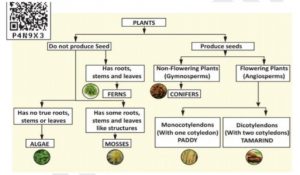 Incorrect
Incorrect
Explanation

-
Question 28 of 47
28. Question
28. Match the following
I. Reptiles 1. Octopus
II. Worm 2. Flatworm
III. Amphibians 3. Salamander
IV. Mollusca 4. CrocodileCorrect
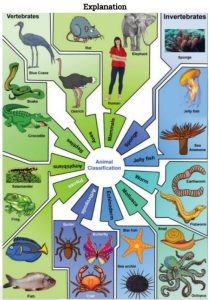 Incorrect
Incorrect

-
Question 29 of 47
29. Question
29. Which of the following statement about mosses is correct?
1) Plant body is differentiated into true root, stem and leaves.
2) They do not have any specialized vascular tissues for conduction of water and food
3) Funaria is an example of mossesCorrect
Explanation
Mosses
Plant body is not differentiated into true root, stem and leaves.
They are water living plants, needs moisture to complete its life cycle. Hence, they are referred to as amphibious plants
They do not have any specialized vascular tissues for conduction of water and food. Examples: Funaria
Incorrect
Explanation
Mosses
Plant body is not differentiated into true root, stem and leaves.
They are water living plants, needs moisture to complete its life cycle. Hence, they are referred to as amphibious plants
They do not have any specialized vascular tissues for conduction of water and food. Examples: Funaria
-
Question 30 of 47
30. Question
30. Which of the following statement about ferns is correct?
1) Plant body is well-differentiated into root, stem, and leaves.
2) Leaves may be large or small
3) Basically, they are the first land plants which grows well in shady, moist, and cool placesCorrect
Explanation
Ferns
Plant body is well-differentiated into root, stem, and leaves. Leaves may be large or small.
Specialized vascular tissues are found for the conduction of water and food.
Basically, they are the first land plants which grows well in shady, moist, and cool places. (Examples: Adiantum)
Incorrect
Explanation
Ferns
Plant body is well-differentiated into root, stem, and leaves. Leaves may be large or small.
Specialized vascular tissues are found for the conduction of water and food.
Basically, they are the first land plants which grows well in shady, moist, and cool places. (Examples: Adiantum)
-
Question 31 of 47
31. Question
31. Which of the following statement about Gymnosperms is correct?
1) Plants are perennial, woody, evergreen with true root, stem and leaves
2) They possess vascular tissues, xylem without vessels and phloem with companion cells.
3) Seeds are naked.Correct
Explanation
Gymnosperms
Plants are perennial, woody, evergreen with true root, stem and leaves.
They possess vascular tissues, xylem without vessels and phloem without companion cells.
Ovules are naked, without ovary. Hence, they do not produce fruits. Seed are naked.
(Examples: Pinus, Cycas)Incorrect
Explanation
Gymnosperms
Plants are perennial, woody, evergreen with true root, stem and leaves.
They possess vascular tissues, xylem without vessels and phloem without companion cells.
Ovules are naked, without ovary. Hence, they do not produce fruits. Seed are naked.
(Examples: Pinus, Cycas) -
Question 32 of 47
32. Question
32. How many whorls does Angiosperms have?
Correct
Explanation
Angiosperms:
Plant body is well differentiated into true root, stem, and leaves.
Angiosperms produce flower with four whorls (calyx, corolla, androecium and gynoecium),
hence known as flowering plants.Incorrect
Explanation
Angiosperms:
Plant body is well differentiated into true root, stem, and leaves.
Angiosperms produce flower with four whorls (calyx, corolla, androecium and gynoecium),
hence known as flowering plants. -
Question 33 of 47
33. Question
33. Which of the following statement is correct?
1) Angiosperms are the dominant plant forms of present da
2) Based on the number of cotyledons, angiosperms are broadly divided into two groupsCorrect
Explanation
Angiosperms are the dominant plant forms of present day. Based on the number of cotyledons, angiosperms are broadly divided into two groups. a) monocotyledons b) dicotyledons.
Incorrect
Explanation
Angiosperms are the dominant plant forms of present day. Based on the number of cotyledons, angiosperms are broadly divided into two groups. a) monocotyledons b) dicotyledons.
-
Question 34 of 47
34. Question
34. Which of the following is matched incorrectly?
1) Monocot – Paddy
2) Dicot – TamarindCorrect
Explanation
Plant seeds which have only one cotyledon are said to be monocots. Plant seeds which have two
cotyledons are known as dicots. Example- Paddy (monocot), tamarind (dicot)Incorrect
Explanation
Plant seeds which have only one cotyledon are said to be monocots. Plant seeds which have two
cotyledons are known as dicots. Example- Paddy (monocot), tamarind (dicot) -
Question 35 of 47
35. Question
35. Who proposed the five-kingdom classification?
Correct
Explanation
The five-kingdom classification was proposed by R.H. Whittaker in 1969. Five kingdoms were formed on the basis of characteristics such as cell structure, mode of nutrition, source of nutrition and body organization.
Incorrect
Explanation
The five-kingdom classification was proposed by R.H. Whittaker in 1969. Five kingdoms were formed on the basis of characteristics such as cell structure, mode of nutrition, source of nutrition and body organization.
-
Question 36 of 47
36. Question
36. Bacteria belongs to which kingdom?
Correct
Explanation
Kingdom Monera – Bacteria:
Most of the bacteria are heterotrophic, but some are autotrophs. Bacteria and Blue green algae are examples for Monera.
Incorrect
Explanation
Kingdom Monera – Bacteria:
Most of the bacteria are heterotrophic, but some are autotrophs. Bacteria and Blue green algae are examples for Monera.
-
Question 37 of 47
37. Question
37. Assertion (A): All prokaryotes belong to the Kingdom Monera
Reason (R): Cells of prokaryotes do not have a nuclear membrane and any membrane bound organelles.Correct
Explanation
All prokaryotes belong to the Kingdom Monera, which do not posses true nucleus. Cells of
prokaryotes do not have a nuclear membrane and any membrane bound organelles.Incorrect
Explanation
All prokaryotes belong to the Kingdom Monera, which do not posses true nucleus. Cells of
prokaryotes do not have a nuclear membrane and any membrane bound organelles. -
Question 38 of 47
38. Question
38. Which of the following statement is correct?
1) The Kingdom Protista includes unicellular and a few simple multicellular eukaryotes.
2) Animals like protists are often called protozoans
3) They include amoeba and paramecium.Correct
Explanation
LThe Kingdom Protista includes unicellular and a few simple multicellular eukaryotes. There are two main groups of protists. The plant like protists are photosynthetic and are commonly called algae. Algae include unicellular and multicellular types. Animals like protists are often called protozoans. They include amoeba and paramecium
Incorrect
Explanation
LThe Kingdom Protista includes unicellular and a few simple multicellular eukaryotes. There are two main groups of protists. The plant like protists are photosynthetic and are commonly called algae. Algae include unicellular and multicellular types. Animals like protists are often called protozoans. They include amoeba and paramecium
-
Question 39 of 47
39. Question
39. Which of the following are included in Kingdom Fungi?
Correct
Explanation
Fungi are eukaryotic, and mostly are multicellular. They secrete enzymes to digest the food and absorb the food after digested by the enzymes. Fungi saprophytes as decomposers (decay –causing organisms) or as parasites. Kingdom Fungi includes molds, mildews, mushrooms and yeast.
Incorrect
Explanation
Fungi are eukaryotic, and mostly are multicellular. They secrete enzymes to digest the food and absorb the food after digested by the enzymes. Fungi saprophytes as decomposers (decay –causing organisms) or as parasites. Kingdom Fungi includes molds, mildews, mushrooms and yeast.
-
Question 40 of 47
40. Question
40. Which of the following statement is correct?
1) Planatae (plants) are multicellular eukaryotes that carry out photosynthesis.
2) Kingdom Plantae includes ferns, cone bearing plants and flowering plants.
3) Plant cells do not have cell wallCorrect
Explanation
Planatae (plants) are multicellular eukaryotes that carry out photosynthesis. Reserve food
materials are starch and lipids in the form of oil or fat. Plant cells have cell wall and specialized
functions, such as photosynthesis, transport of materials and support. Kingdom Plantae includes ferns, cone bearing plants and flowering plants.Incorrect
Explanation
Planatae (plants) are multicellular eukaryotes that carry out photosynthesis. Reserve food
materials are starch and lipids in the form of oil or fat. Plant cells have cell wall and specialized
functions, such as photosynthesis, transport of materials and support. Kingdom Plantae includes ferns, cone bearing plants and flowering plants. -
Question 41 of 47
41. Question
41. Which of the following is matched correctly?
1) Vertebrates- Birds
2) Invertebrates – FlatwormsCorrect
Explanation
Invertebrates like sponges, hydra,flatworms, round worms, insects, snails, starfishes. Vertebrates
like Fish, amphibians, reptiles, birds, and mammals including human beings belong to the kingdom Animalia.Incorrect
Explanation
Invertebrates like sponges, hydra,flatworms, round worms, insects, snails, starfishes. Vertebrates
like Fish, amphibians, reptiles, birds, and mammals including human beings belong to the kingdom Animalia. -
Question 42 of 47
42. Question
42. Which of the following statement about Animalia is correct?
1) Animalia (animals) are multicellular, eukaryotic and heterotrophic animals
2) Cells have cell wall
3) Most members of the animal kingdom can move from place to placeCorrect
Explanation
Animalia (animals) are multicellular, eukaryotic and heterotrophic animals. Cells have no cell wall. Most members of the animal kingdom can move from place to place.
Incorrect
Explanation
Animalia (animals) are multicellular, eukaryotic and heterotrophic animals. Cells have no cell wall. Most members of the animal kingdom can move from place to place.
-
Question 43 of 47
43. Question
43. Which of the following about five Kingdom Classification is correct?
1) This system of classification is more scientific and natura
2) It is the most accepted system of modern classification as the different groups of organisms
are placed phylogenetically
3) It indicates gradual evolution of complex organisms from simpler oneCorrect
Explanation
Merits of five Kingdom Classification:
This system of classification is more scientific and natural.
This system of classification clearly indicates the cellular organization, mode of nutrition,
and characters for early evolution of life.
It is the most accepted system of modern classification as the different groups of organisms
are placed phylogenetically. It indicates gradual evolution of complex organisms from simpler one.
It indicates gradual evolution of complex organisms from simpler one.Incorrect
Explanation
Merits of five Kingdom Classification:
This system of classification is more scientific and natural.
This system of classification clearly indicates the cellular organization, mode of nutrition,
and characters for early evolution of life.
It is the most accepted system of modern classification as the different groups of organisms
are placed phylogenetically. It indicates gradual evolution of complex organisms from simpler one.
It indicates gradual evolution of complex organisms from simpler one. -
Question 44 of 47
44. Question
44. Who implemented Binomial Nomenclature?
Correct
Explanation
Gaspard Bauhin in 1623, introduced naming of organisms with two names which is known as Binomial nomenclature, and it was implemented by Carolus Linnaeas in 1753. He is known as ‘Father of Modern Taxonomy’.
Incorrect
Explanation
Gaspard Bauhin in 1623, introduced naming of organisms with two names which is known as Binomial nomenclature, and it was implemented by Carolus Linnaeas in 1753. He is known as ‘Father of Modern Taxonomy’.
-
Question 45 of 47
45. Question
45. Which of the following statement is correct?
1) Binomial nomenclature is a universal system of naming organisms.
2) First is the Genus name, second is the Species name.
3) Genus name begins with a capital letter and Species name begins with a small letter.Correct
Explanation
Binomial nomenclature is a universal system of naming organisms. As per this system, each organism has two names – the first is the Genus name and the second is the Species name. Genus name begins with a capital letter and Species name begins with a small letter.
Incorrect
Explanation
Binomial nomenclature is a universal system of naming organisms. As per this system, each organism has two names – the first is the Genus name and the second is the Species name. Genus name begins with a capital letter and Species name begins with a small letter.
-
Question 46 of 47
46. Question
46. Match the following
I. Human being 1. Rattus rattus
II. Pigeon 2. Homo sapiens
III. Onion 3. Allium sativum
IV. Rat 4. Columba liviaCorrect
Explanation
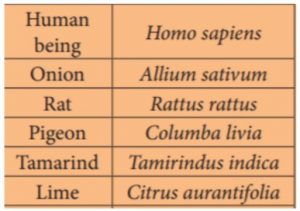 Incorrect
Incorrect
Explanation

-
Question 47 of 47
47. Question
47. Match the following
I. Coconut 1. Catla catla
II. Fish 2. Cocos nucifera
III. Ginger 3. Zingiber officinale
IV. Date 4. Phoenix dactyliferaCorrect
Explanation
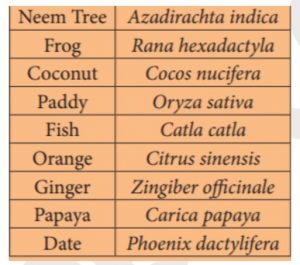 Incorrect
Incorrect
Explanation

Leaderboard: Basis of Classification Online Test 7th Science Lesson 11 Questions in English
| Pos. | Name | Entered on | Points | Result |
|---|---|---|---|---|
| Table is loading | ||||
| No data available | ||||
quiz score